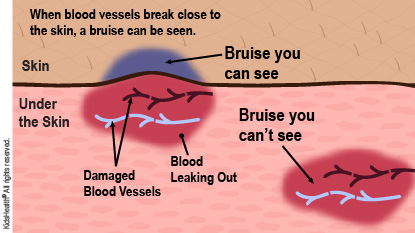Finger Bruise: How to Care for Your Child
A bruise (also called a contusion) happens when small blood vessels under the skin leak blood after an injury. The trapped blood might show as red or purple marks on the skin or, if the bruise is very deep and involves the muscle, nothing may be visible on the skin. A bruise usually hurts when touched, especially for the first few days after the injury.
As bruises heal, they may turn different colors as they fade away. Most are gone after 2 weeks.


For 2–3 days, to help with pain and swelling:
-
If your health care provider says it's OK, give your child medicines like acetaminophen (Tylenol® or a store brand) or ibuprofen (Advil®, Motrin®, or a store brand) as needed for pain. Follow the directions on the label for how much to give and how often.
-
Place ice wrapped in a towel on the bruise for about 20 minutes several times a day. Do not put ice directly on the skin.
-
Wrap the finger in an elastic bandage or use a splint. It should be tight enough to give support but loose enough that you can easily put a finger under it.
-
Keep the finger above heart level by resting it on a pillow.
Follow your health care provider's advice for:
-
Any exercises or stretches your child should do and any activities to avoid.
-
If you should try a heating pad (usually about 2 days after the injury).
-
When your child should follow up.


Your child:

How do health care providers diagnose a finger bruise? Health care providers carefully examine the injured area and ask about what happened. Usually no testing is needed, but sometimes they order an X-ray to make sure there are no other injuries.
How do bruises heal? Bruises usually go away in 2 weeks. While it heals, the bruise changes color as the body breaks down the blood:
-
At first, a bruise looks red or pink because of the trapped blood under the skin.
-
Within 1–2 days, the bruise will look bluish-purple or sometimes black.
-
After 5–10 days, the bruise looks green or yellow.
-
After 10–14 days, the bruise may turn yellow-brown or light brown.
What can help prevent finger bruises? Most kids will get bruises from time to time. But it can help to:
-
Wear protective gear and gloves for sports.
-
Protect their fingers when biking, doing gymnastics, or wrestling.
-
Use proper technique during sports and practices.
-
Be careful of fingers when closing car doors and other doors.
-
Use caution when climbing a tree and using playground equipment.